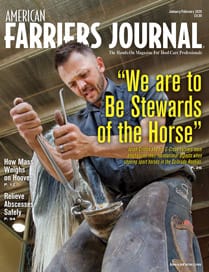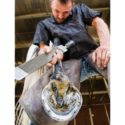Advertise Follow Us
American Farriers Journal

View Archived Issues
January/February 2020
Volume: 46
Edition: 1
American Farriers Journal is the “hands-on” magazine for professional farriers, equine veterinarians and horse care product and service buyers.
-
Table Of Contents
Table Of Contents
Body Mass and Height Influence Horses’ Feet
Additional mass placed on the hoof can negatively affect equine welfareRead MoreShoeing For A LivingBuilding Upon a Foundation of Sound Farriery
C-Cross Farriers advocate for the horse and each other for a successful multi-farrier practiceRead MoreImprove Recognition of Hoof Distortion by Drawing One
Graphing exercise can help farriers improve their trimRead MoreEquine Reciprocating Systems: Examining the Shoulder to Thorax Junction
In the fourth in this series, Dr. Deb Bennett illustrates the relationship between the horse’s forelimb and the body.Read MoreDetecting and Treating Subsolar Abscesses
A conservative approach may provide relief without compromising overall hoof integrityRead MoreFarrier Input in Pre-Purchase Exams is Rare
Survey shows hat farrier participation in pre-purchase examRead MoreResearch Journal: January/February 2020
The information, ideas and opinions expressed are those of the author and do not necessarily represent those of the United States Department of Agriculture.”Read More -
Featured Articles
Featured Articles
Improve Recognition of Hoof Distortion by Drawing One
Graphing exercise can help farriers improve their trimRead MoreShoeing For A LivingBuilding Upon a Foundation of Sound Farriery
C-Cross Farriers advocate for the horse and each other for a successful multi-farrier practiceRead MoreDetecting and Treating Subsolar Abscesses
A conservative approach may provide relief without compromising overall hoof integrityRead More - Digital Edition
-
Online Extras
Online Extras














